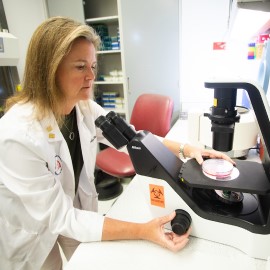
Natalie R. Bauer, Ph.D.
Biography
Dr. Natalie R. Bauer, Associate Professor, received her Baccalaureate in Biology from Delta State University in Cleveland, MS, and her Ph.D. in Basic Medical Sciences from the University of South Alabama. Dr. Bauer completed a postdoctoral fellowship in the Laboratory of Cardiovascular and Pulmonary Science at the University of Colorado Health Sciences Center, Denver, CO. She has previously served as module director for the Gastrointestinal Module (Medical School) and the course director for Signal Transduction (Graduate School). Dr. Bauer is currently an Associate Professor with Tenure and the Assistant Dean for Admissions for the Frederick P. Whiddon College of Medicine.
Research
Current Research Interest
Extracellular Vesicles: A role for damage and repair in pulmonary vascular disease
The Bauer laboratory specializes in pulmonary vascular disease with an emphasis on pulmonary hypertension. High blood pressure in the pulmonary circulation leads to right heart failure and currently there are no treatments for the high pressure, vascular damage or the right heart. Survival following diagnosis with pulmonary hypertension is, on average, 5 years, so the need for therapy is urgent.
Extracellular vesicles (EVs) are circulating, intact vesicles that are under 1mm in diameter derived from resident cells. Our laboratory focus is on EVs in the circulation; however, they can be found in most bodily fluids. We were the first to find that EVs circulating in pulmonary hypertension induce inflammatory molecules on the endothelial cells of the pulmonary vascular bed. Inflammation in turn contributes to the progressive worsening of PH.
An emerging target for restoration of healthy vessels in PH is reversal of endothelial dysfunction. The second messenger, cyclic adenosine monophosphate (cAMP), positively regulates endothelial proliferation, release of endothelial derived vasodilators and endothelial inflammation. Our recent work using cell culture derived EVs loaded with cAMP shows the EV ability to induce cAMP signaling in pulmonary endothelium and data suggest the cAMP-EVs improve outcomes in PH.
The longstanding goal of the lab is to understand the role of extracellular vesicles in pulmonary vascular disease and repair. Our translational goal is to develop therapy to prevent the effects of deleterious EVs while advancing knowledge sufficient to use EVs as drug delivery systems.
Publications
Houserova D, Huang Y, Kasukurthi M, Watters B, Khan F, Mehta R, Chaudhary N, Roberts J, DeMeis J, Hobbs T, Ghee K, McInnis C, Johns N, Kegler A, Coley A, Brown C, Hewes J, McElyea M, Reeves M, Tran T, Bauer N, Huang J, Audia J, Foster J, Borchert G. Salmonella outer membrane vesicles contain tRNA fragments (tRFs) that inhibit bacteriophage P22 infection. Nature Communications 2023, Under Revision.
Stevens RP, Lee JY, Bauer N, Stevens T. Got Oxygen? Studies on Mesenchymal Cell Hypoxia Inducible Factor-1α in Lung Development. Am J Respir Cell Mol Biol. 2023 Oct;69(4):380-382. doi: 10.1165/rcmb.2023-0247ED. PMID: 37478332; PMCID: PMC10557915.
Moore BB, Ballinger MN, Bauer NN, Blackwell TS, Borok Z, Budinger GRS, Camoretti-Mercado B, Erzurum SC, Himes BE, Keshamouni VG, Kulkarni HS, Mallampalli RK, Mariani TJ, Martinez FJ, McCombs JE, Newcomb DC, Johnston RA, O'Reilly MA, Prakash YS, Ridge KM, Sime PJ, Sperling AI, Violette S, Wilkes DS, Königshoff M. Building Career Paths for Ph.D., Basic and Translational Scientists in Clinical Departments in the United States: An Official American Thoracic Society Workshop Report. Ann Am Thorac Soc. 2023 Aug;20(8):1077-1087. doi: 10.1513/AnnalsATS.202304-305ST. PMID: 37526479; PMCID: PMC10405615.
D'Addario CA, Lanier GM, Jacob C, Bauer N, Hewes JL, Bhadra A, Gupte SA. Differences in the expression of DNA methyltransferases and demethylases in leukocytes and the severity of pulmonary arterial hypertension between ethnic groups. Physiol Rep. 2022 May;10(10):e15282. doi: 10.14814/phy2.15282. PubMed PMID: 35581740; PubMed Central PMCID: PMC9114656.
Bhadra A, Scruggs AK, Leavesley SJ, Annamdevula N, George AH, Britain AL, Francis CM, Knighten JM, Rich TC, Bauer NN. Extracellular vesicle-induced cyclic AMP signaling. Cell Signal. 2022 Jul;95:110348. doi: 10.1016/j.cellsig.2022.110348. Epub 2022 Apr 30. PMID: 35504529; PMCID: PMC10676271.
Bhadra A, Hewes JL, Scruggs A, Zhou C, Lee JY, Bauer N. Extracellular cAMP: The Past and Visiting the Future in cAMP-Enriched Extracellular Vesicles. Adv Biol (Weinh). 2021 Dec;5(12):e2101064. doi: 10.1002/adbi.202101064. Epub 2021 Oct 28. PubMed PMID: 34713635; PubMed Central PMCID: PMC8767638.


